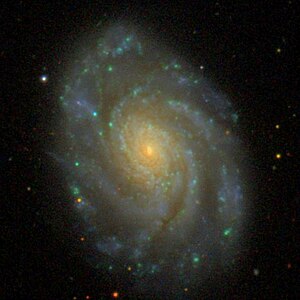NGC 3810
| Galaxy NGC 3810 |
|
|---|---|

|
|
| SDSS recording | |
| AladinLite | |
| Constellation | lion |
|
Position equinox : J2000.0 , epoch : J2000.0 |
|
| Right ascension | 11 h 40 m 58.7 s |
| declination | + 11 ° 28 ′ 16 ″ |
| Appearance | |
| Morphological type | SA (rs) c / HII |
| Brightness (visual) | 10.6 mag |
| Brightness (B-band) | 11.3 mag |
| Angular expansion | 4.3 ′ × 3 ′ |
| Position angle | 15 ° |
| Surface brightness | 13.2 mag / arcmin² |
| Physical data | |
| Affiliation | Leo II group |
| Redshift | 0.003309 +/- 0.000002 |
| Radial velocity | 992 ± 1 km / s |
|
Stroke distance v rad / H 0 |
(41 ± 3) x 10 6 ly (12.5 ± 0.9) Mpc |
| diameter | 60,000 ly |
| history | |
| discovery | Wilhelm Herschel |
| Discovery date | March 15, 1784 |
| Catalog names | |
| NGC 3810 • UGC 6644 • PGC 36243 • CGCG 068-024 • MCG + 02-30-010 • IRAS 11383 + 1144 • 2MASX J11405873 + 1128160 • GC 2499 • H I 21 • h 943 • HIPASS J1140 + 11 • EVCC 3 | |
NGC 3810 is a spiral galaxy with extensive star formation regions of the Hubble type Sc in the constellation Leo north of the ecliptic . It is around 41 million light years away from the Milky Way and has a diameter of around 60,000 light years . The location and distance of the object suggest membership in the Virgo cluster .
The Type Ic supernovae SN 1997dq and SN 2000ew were observed here.

High-resolution image of the center of NGC 3810, taken with the Hubble Space Telescope
The object was discovered on March 15, 1784 by the German-British astronomer Wilhelm Herschel .
Web links
Commons : NGC 3810 - collection of images, videos, and audio files
